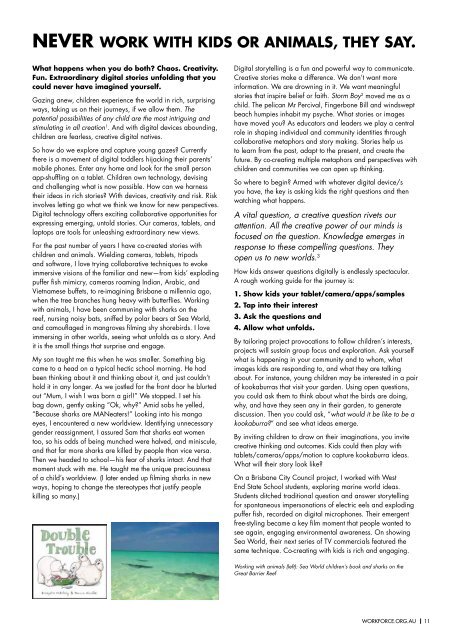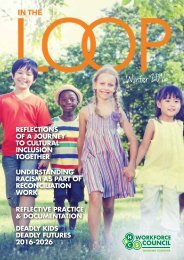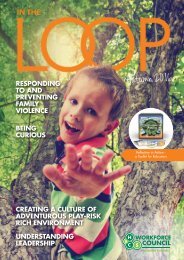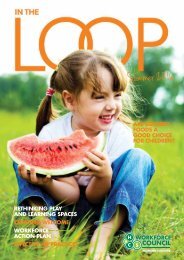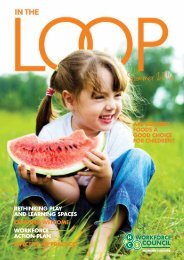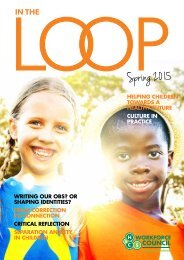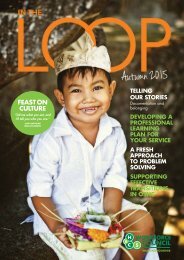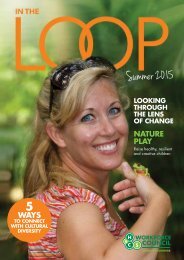Winter 2015
You also want an ePaper? Increase the reach of your titles
YUMPU automatically turns print PDFs into web optimized ePapers that Google loves.
NEVER WORK WITH KIDS OR ANIMALS, THEY SAY.<br />
What happens when you do both? Chaos. Creativity.<br />
Fun. Extraordinary digital stories unfolding that you<br />
could never have imagined yourself.<br />
Gazing anew, children experience the world in rich, surprising<br />
ways, taking us on their journeys, if we allow them. The<br />
potential possibilities of any child are the most intriguing and<br />
stimulating in all creation 1 . And with digital devices abounding,<br />
children are fearless, creative digital natives.<br />
So how do we explore and capture young gazes? Currently<br />
there is a movement of digital toddlers hijacking their parents’<br />
mobile phones. Enter any home and look for the small person<br />
app-shuffling on a tablet. Children own technology, devising<br />
and challenging what is now possible. How can we harness<br />
their ideas in rich stories? With devices, creativity and risk. Risk<br />
involves letting go what we think we know for new perspectives.<br />
Digital technology offers exciting collaborative opportunities for<br />
expressing emerging, untold stories. Our cameras, tablets, and<br />
laptops are tools for unleashing extraordinary new views.<br />
For the past number of years I have co-created stories with<br />
children and animals. Wielding cameras, tablets, tripods<br />
and software, I love trying collaborative techniques to evoke<br />
immersive visions of the familiar and new—from kids’ exploding<br />
puffer fish mimicry, cameras roaming Indian, Arabic, and<br />
Vietnamese buffets, to re-imagining Brisbane a millennia ago,<br />
when the tree branches hung heavy with butterflies. Working<br />
with animals, I have been communing with sharks on the<br />
reef, nursing noisy bats, sniffed by polar bears at Sea World,<br />
and camouflaged in mangroves filming shy shorebirds. I love<br />
immersing in other worlds, seeing what unfolds as a story. And<br />
it is the small things that surprise and engage.<br />
My son taught me this when he was smaller. Something big<br />
came to a head on a typical hectic school morning. He had<br />
been thinking about it and thinking about it, and just couldn’t<br />
hold it in any longer. As we jostled for the front door he blurted<br />
out “Mum, I wish I was born a girl!” We stopped. I set his<br />
bag down, gently asking “Ok, why?” Amid sobs he yelled,<br />
“Because sharks are MANeaters!” Looking into his manga<br />
eyes, I encountered a new worldview. Identifying unnecessary<br />
gender reassignment, I assured Sam that sharks eat women<br />
too, so his odds of being munched were halved, and miniscule,<br />
and that far more sharks are killed by people than vice versa.<br />
Then we headed to school—his fear of sharks intact. And that<br />
moment stuck with me. He taught me the unique preciousness<br />
of a child’s worldview. (I later ended up filming sharks in new<br />
ways, hoping to change the stereotypes that justify people<br />
killing so many.)<br />
Digital storytelling is a fun and powerful way to communicate.<br />
Creative stories make a difference. We don’t want more<br />
information. We are drowning in it. We want meaningful<br />
stories that inspire belief or faith. Storm Boy 2 moved me as a<br />
child. The pelican Mr Percival, Fingerbone Bill and windswept<br />
beach humpies inhabit my psyche. What stories or images<br />
have moved you? As educators and leaders we play a central<br />
role in shaping individual and community identities through<br />
collaborative metaphors and story making. Stories help us<br />
to learn from the past, adapt to the present, and create the<br />
future. By co-creating multiple metaphors and perspectives with<br />
children and communities we can open up thinking.<br />
So where to begin? Armed with whatever digital device/s<br />
you have, the key is asking kids the right questions and then<br />
watching what happens.<br />
A vital question, a creative question rivets our<br />
attention. All the creative power of our minds is<br />
focused on the question. Knowledge emerges in<br />
response to these compelling questions. They<br />
open us to new worlds. 3<br />
How kids answer questions digitally is endlessly spectacular.<br />
A rough working guide for the journey is:<br />
1. Show kids your tablet/camera/apps/samples<br />
2. Tap into their interest<br />
3. Ask the questions and<br />
4. Allow what unfolds.<br />
By tailoring project provocations to follow children’s interests,<br />
projects will sustain group focus and exploration. Ask yourself<br />
what is happening in your community and to whom, what<br />
images kids are responding to, and what they are talking<br />
about. For instance, young children may be interested in a pair<br />
of kookaburras that visit your garden. Using open questions,<br />
you could ask them to think about what the birds are doing,<br />
why, and have they seen any in their garden, to generate<br />
discussion. Then you could ask, “what would it be like to be a<br />
kookaburra?” and see what ideas emerge.<br />
By inviting children to draw on their imaginations, you invite<br />
creative thinking and outcomes. Kids could then play with<br />
tablets/cameras/apps/motion to capture kookaburra ideas.<br />
What will their story look like?<br />
On a Brisbane City Council project, I worked with West<br />
End State School students, exploring marine world ideas.<br />
Students ditched traditional question and answer storytelling<br />
for spontaneous impersonations of electric eels and exploding<br />
puffer fish, recorded on digital microphones. Their emergent<br />
free-styling became a key film moment that people wanted to<br />
see again, engaging environmental awareness. On showing<br />
Sea World, their next series of TV commercials featured the<br />
same technique. Co-creating with kids is rich and engaging.<br />
Working with animals (left): Sea World children’s book and sharks on the<br />
Great Barrier Reef<br />
WORKFORCE.ORG.AU 11


